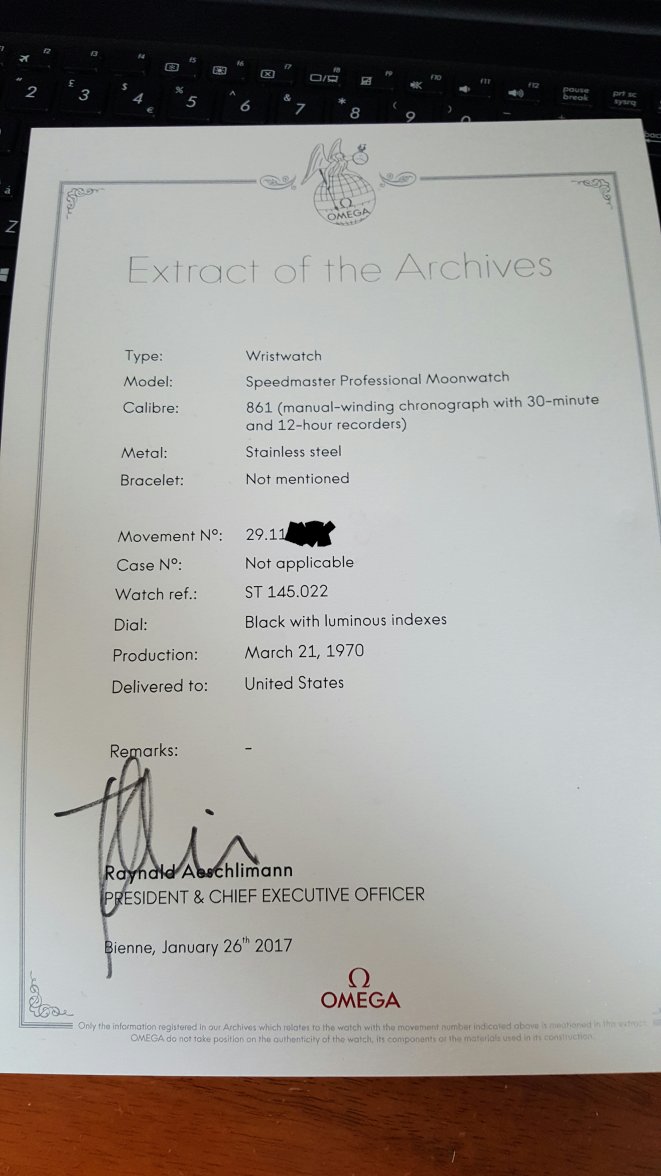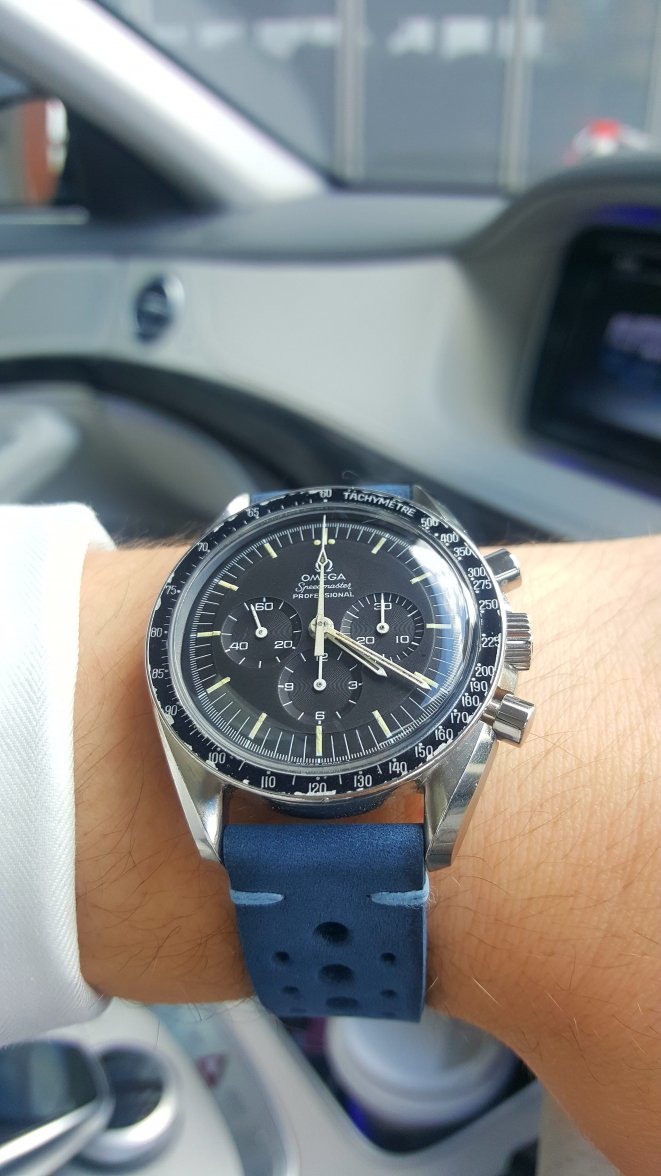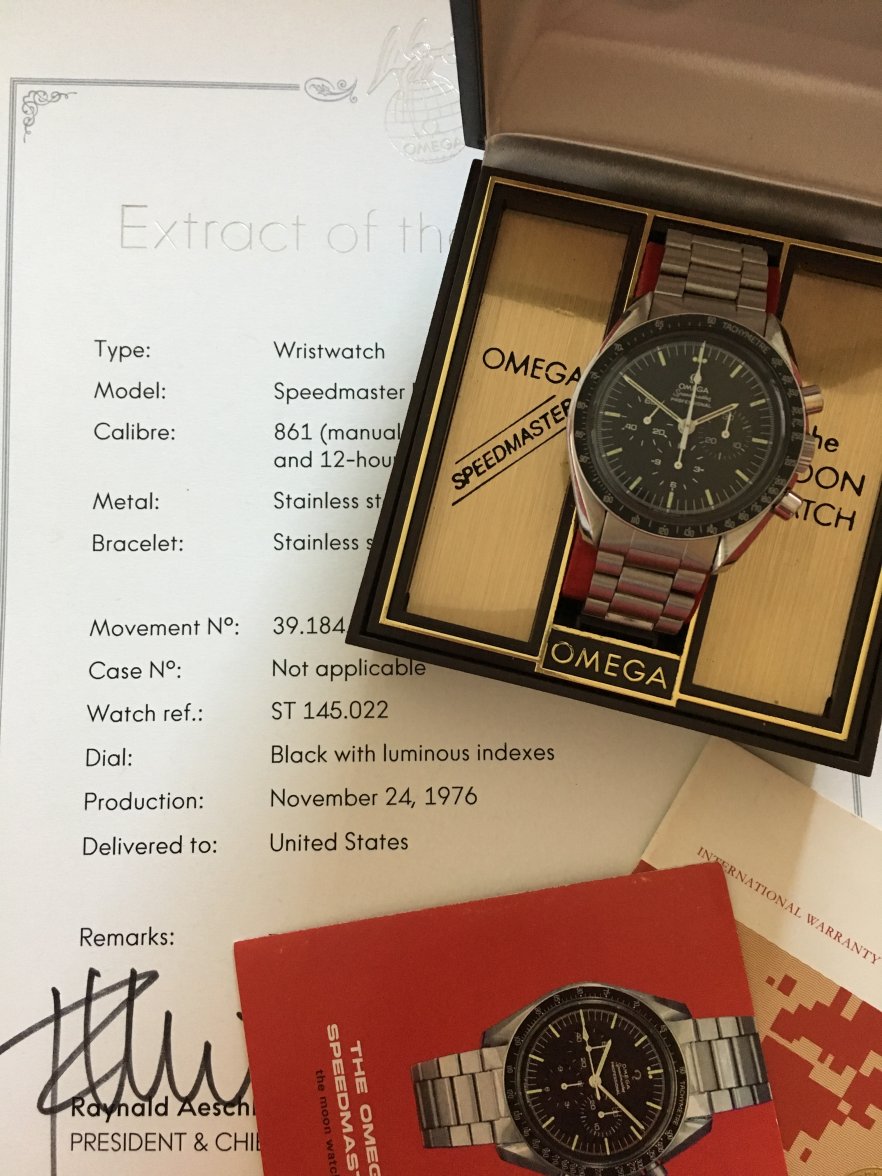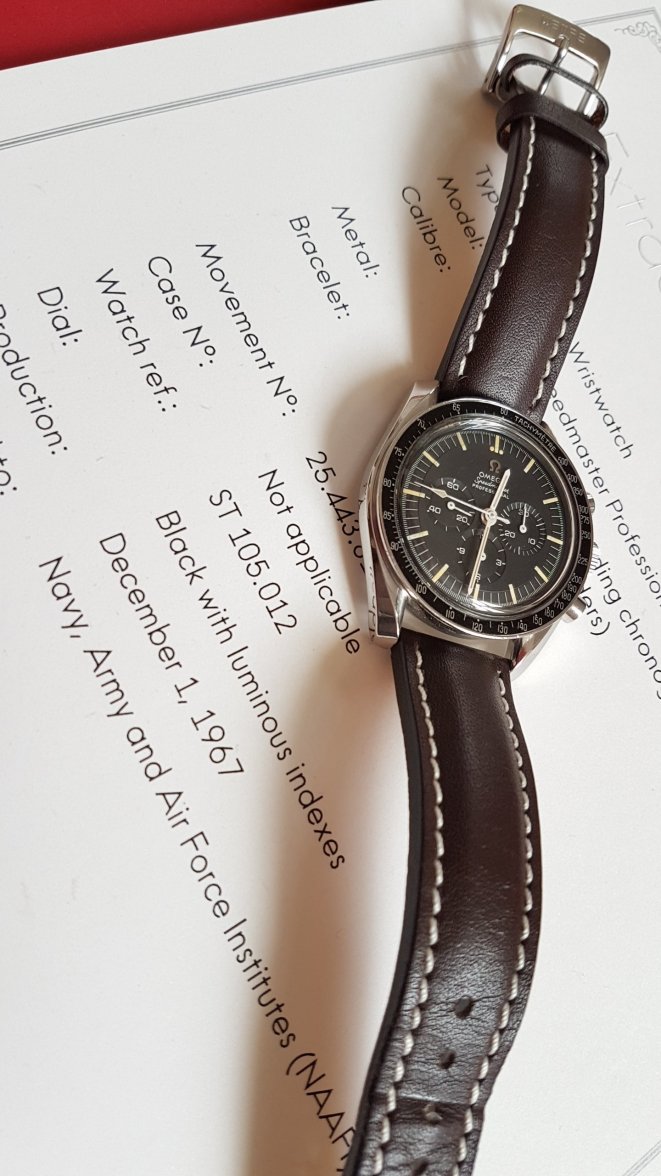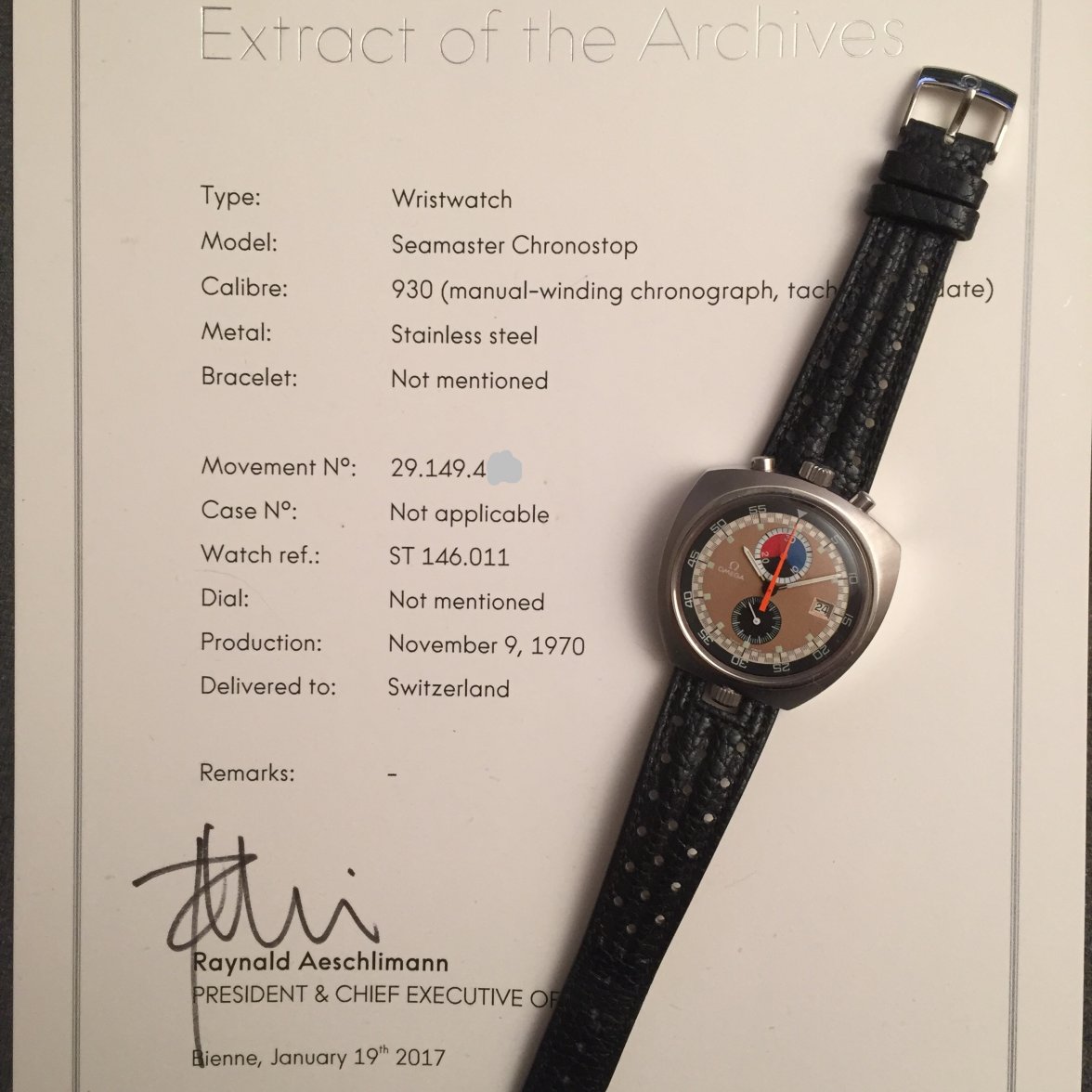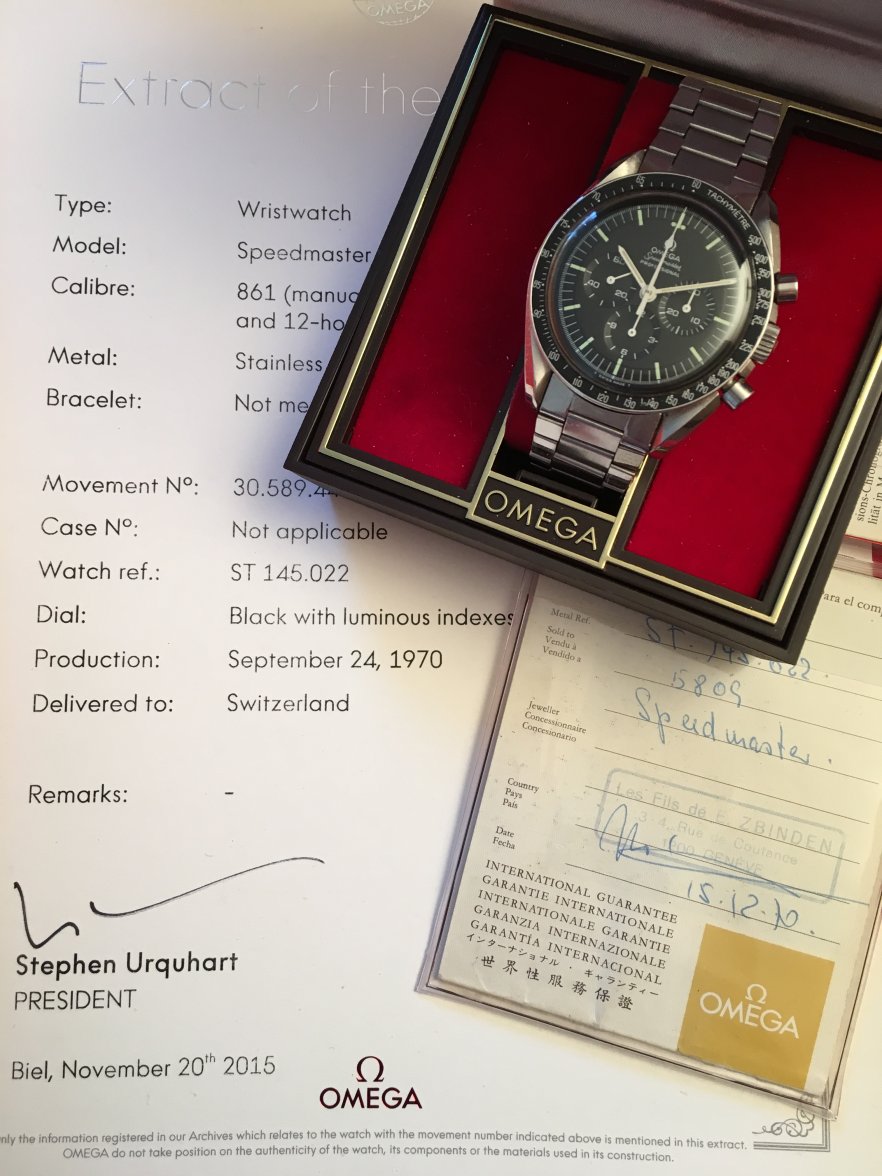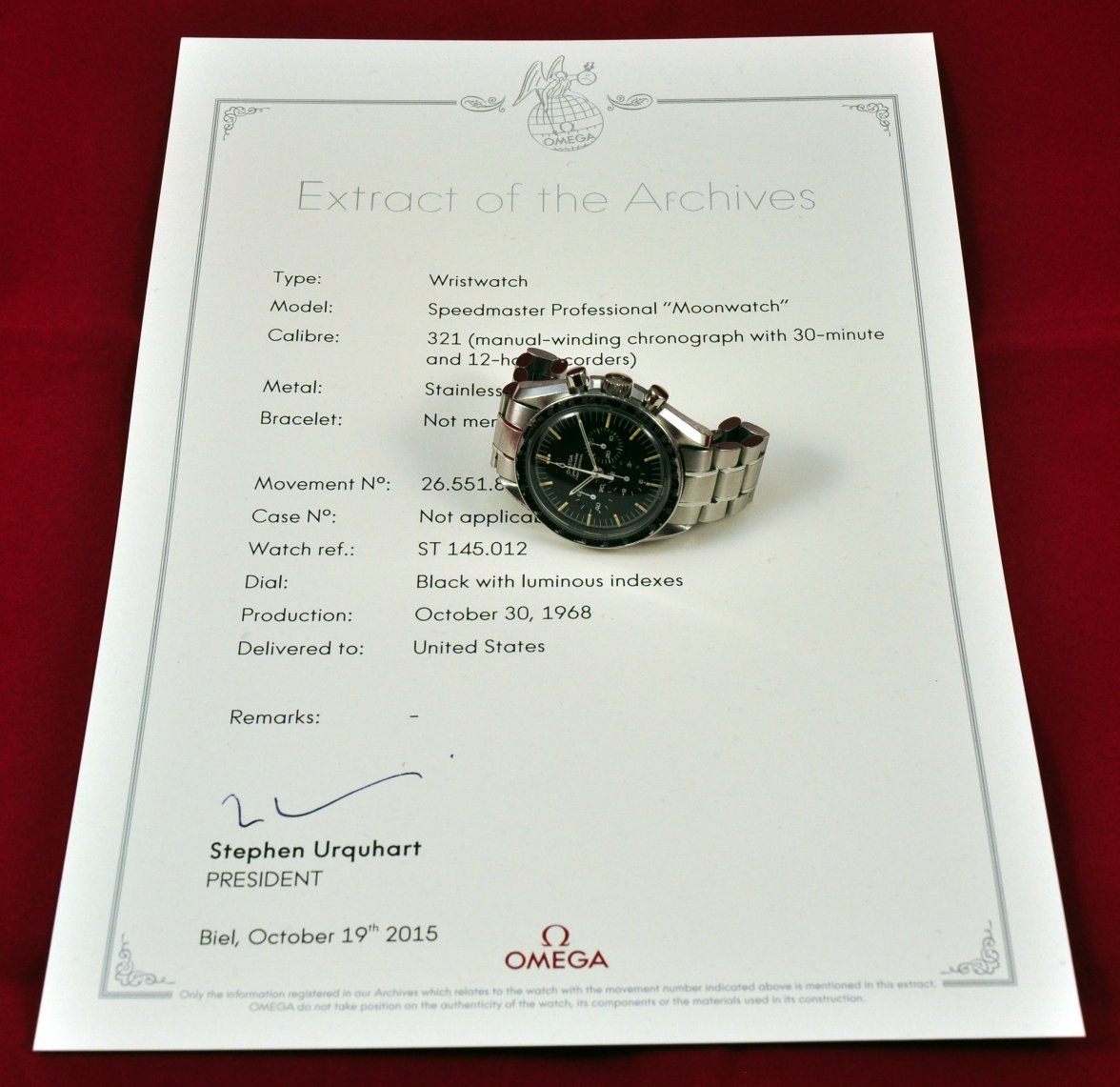Speedy production dates: an alternative to Hartmann's table?
WurstEver
·Very nice, @Hattrick. Love that strap!
OK, so now we have three methods to compare for your watch with SN 2911610x ...
Hartmann's table: 1970 (CORRECT YEAR)
Polynomial model: April, 1970 (CORRECT YEAR, OUT BY 1 MONTH)
Linear interpolation: March, 1970 (TWO FOR TWO! CORRECT YEAR AND MONTH)
Solid results! Thanks 😀
OK, so now we have three methods to compare for your watch with SN 2911610x ...
Hartmann's table: 1970 (CORRECT YEAR)
Polynomial model: April, 1970 (CORRECT YEAR, OUT BY 1 MONTH)
Linear interpolation: March, 1970 (TWO FOR TWO! CORRECT YEAR AND MONTH)
Solid results! Thanks 😀
mr_yossarian
·Very nice, @Hattrick. Love that strap!
OK, so now we have three methods to compare for your watch with SN 2911610x ...
Hartmann's table: 1970 (CORRECT YEAR)
Polynomial model: April, 1970 (CORRECT YEAR, OUT BY 1 MONTH)
Linear interpolation: March, 1970 (TWO FOR TWO! CORRECT YEAR AND MONTH)
Solid results! Thanks 😀
eugeneandresson
·Very nice, @Hattrick. Love that strap!
OK, so now we have three methods to compare for your watch with SN 2911610x ...
Hartmann's table: 1970 (CORRECT YEAR)
Polynomial model: April, 1970 (CORRECT YEAR, OUT BY 1 MONTH)
Linear interpolation: March, 1970 (TWO FOR TWO! CORRECT YEAR AND MONTH)
Solid results! Thanks 😀
In this case 👍
IMHO Hartmann's table is not a running candidate for this solution as 1 of 3 (or more!) approaches due to lack of monthly granularity (i.e. 'best vote of X' or 'average of X')...
EDIT : So the correct item here was the 'nearest neighbourhood linear interpolation'...awesome 😀
Edited:
JMH76
·I think you've got it. Of course this works only if all the s/n's and dates are monotonic. If some are out of order you'll have to implement some IF statements to check to see if your subject is in the out-of-order range and do a different lookup for that range.
I would expect that no method will be perfect as I'm sure at the microscopic level the points won't fall on any regular curve or line so voting among methods might not improve the overall accuracy. Any statisticians out there?
I would expect that no method will be perfect as I'm sure at the microscopic level the points won't fall on any regular curve or line so voting among methods might not improve the overall accuracy. Any statisticians out there?
JMH76
·This is a little off-topic but bear with me.
Why do we want to know when our Speedmaster was produced? Is it just curiosity or is there a more compelling reason? For me, and probably for many, it's to know whether a watch you're about to buy is correct or not, and to know that you need to know when it was produced. But that is just half the battle; you also need to know what is period-correct.
Prior to the purchase of my Speedmaster Moonwatch, I did a lot of research on the various Speedmaster vintages. There have been so many little detail changes that when looking at potential purchases I found it difficult to assess whether a given watch was correct or not, there being so many details to check. I therefore made up a spreadsheet starting with Hartman’s serial number chart and cribbing additional data from Maddox and Richon. Then I went through the various articles on Fratello, Hodinkee, Speedmaster101, Watchprosite, etc. and added the relevant and most up-to-date knowledge to the spreadsheet for key details year-by-year. I should note that while there was a lot of duplication between sites, there was not always agreement among the various sources as to when a particular feature appeared or disappeared so I've had to make some judgments. Probably someone has done something similar to chronicle the changes but a search of the term “spreadsheet” did not turn up anything in the forum.
I’m sure my spreadsheet has some errors in it and probably more could be added to it. The work on serial numbers and dates of production in this thread could be incorporated to better define the applicable s/n ranges. Additionally, comments from forum members (and blogging "experts" like Robert-Jan) could be incorporated to improve it. Perhaps if we get it to an acceptable state it could be posted in the forum permanently and maintained by the community as new information comes to light.
On the other hand, such a table could be used for nefarious purposes by those who create franken-watches in order to make their wares appear more authentic.
What do you think? Any interest? If so, what's the best way to disseminate it on this forum, Dropbox link? Should I start a new thread?
Why do we want to know when our Speedmaster was produced? Is it just curiosity or is there a more compelling reason? For me, and probably for many, it's to know whether a watch you're about to buy is correct or not, and to know that you need to know when it was produced. But that is just half the battle; you also need to know what is period-correct.
Prior to the purchase of my Speedmaster Moonwatch, I did a lot of research on the various Speedmaster vintages. There have been so many little detail changes that when looking at potential purchases I found it difficult to assess whether a given watch was correct or not, there being so many details to check. I therefore made up a spreadsheet starting with Hartman’s serial number chart and cribbing additional data from Maddox and Richon. Then I went through the various articles on Fratello, Hodinkee, Speedmaster101, Watchprosite, etc. and added the relevant and most up-to-date knowledge to the spreadsheet for key details year-by-year. I should note that while there was a lot of duplication between sites, there was not always agreement among the various sources as to when a particular feature appeared or disappeared so I've had to make some judgments. Probably someone has done something similar to chronicle the changes but a search of the term “spreadsheet” did not turn up anything in the forum.
I’m sure my spreadsheet has some errors in it and probably more could be added to it. The work on serial numbers and dates of production in this thread could be incorporated to better define the applicable s/n ranges. Additionally, comments from forum members (and blogging "experts" like Robert-Jan) could be incorporated to improve it. Perhaps if we get it to an acceptable state it could be posted in the forum permanently and maintained by the community as new information comes to light.
On the other hand, such a table could be used for nefarious purposes by those who create franken-watches in order to make their wares appear more authentic.
What do you think? Any interest? If so, what's the best way to disseminate it on this forum, Dropbox link? Should I start a new thread?
eugeneandresson
·Why do we want to know when our Speedmaster was produced?
it's to know whether a watch you're about to buy is correct or not
Exactly this reason...
I therefore made up a spreadsheet starting with Hartman’s serial number chart and cribbing additional data from Maddox and Richon. Then I went through the various articles on Fratello, Hodinkee, Speedmaster101, Watchprosite, etc. and added the relevant and most up-to-date knowledge to the spreadsheet for key details year-by-year.
...without having to necessarily do this (i.e. cross reference every table in existence).
Externals can be verified with MWO or Speedmaster101, but the movement not so easily (Extract is the only way). I have seen serial numbers in Hartmanns tables that (I thought) contradict what original owners say, by 2 years, making one question provinence. And then saving grace, I have seen extracts that prove the tables wrong, provinence to the owners restored (and then double checking with the 'model', which so far seem VERY good). Conversely, it would be good to easily check that someone is telling the truth about the movement (i.e. its an XX year vintage).
Lastly : why not?! its hellova interesting! If we did not try and improve our way of life, we would still be sitting in caves, wearing loin-clothes, beating each other over the heads with sticks...
EDIT : for other details, MWO and Speedmaster101 are pretty much superb.
EDIT EDIT : from what I have seen in some posts, some member are running from cave to cave beating each other with sticks (cant say what they are wearing though) 😁
Edited:
Nactex
·As a former math teacher, linear functions are a great predictor and the more input of information, the more accurate it gets. I see in later charts horizontal lines have been added, should vertical lines also be added? I believe that the original chart presented on a graph paper grid would make it easy to use and understand.
incabloc
·WurstEver
·Thanks @incabloc 😀 and happy Speedy Tuesday!
This is interesting, because your serial number falls in a region where we do not currently have much data. Let's see how we go ...
Hartmann's table: 1979 (INCORRECT YEAR)
Polynomial model: September, 1976 (CORRECT YEAR, OUT BY 2 MONTHS)
Linear interpolation: April, 1976 (CORRECT YEAR, OUT BY 7 MONTHS)
So, even though we didn't get a direct hit, I think this is a good result for the new methods. The table was out by three years. This is just the kind of error that has led many to criticise the table and has encouraged the view that the production process is too random to deal with in any systematic way.
However, both of the new methods predicted the correct year for your watch. The linear interpolation method predicted your production date to within 7 months. Even though that region of the data set is pretty sparse, your serial number fell between, and fairly close to, two existing observations. The polynomial model performed a little better, picking the production date to within two months. I haven't given this a lot of thought yet, but cases like this are probably going to be useful in deciding how we combine estimates to get the most accurate predictions possible.
Thanks again 👍
This is interesting, because your serial number falls in a region where we do not currently have much data. Let's see how we go ...
Hartmann's table: 1979 (INCORRECT YEAR)
Polynomial model: September, 1976 (CORRECT YEAR, OUT BY 2 MONTHS)
Linear interpolation: April, 1976 (CORRECT YEAR, OUT BY 7 MONTHS)
So, even though we didn't get a direct hit, I think this is a good result for the new methods. The table was out by three years. This is just the kind of error that has led many to criticise the table and has encouraged the view that the production process is too random to deal with in any systematic way.
However, both of the new methods predicted the correct year for your watch. The linear interpolation method predicted your production date to within 7 months. Even though that region of the data set is pretty sparse, your serial number fell between, and fairly close to, two existing observations. The polynomial model performed a little better, picking the production date to within two months. I haven't given this a lot of thought yet, but cases like this are probably going to be useful in deciding how we combine estimates to get the most accurate predictions possible.
Thanks again 👍
Foo2rama
··Nowhere near as grumpy as he used to be...WurstEver
·Prior to the purchase of my Speedmaster Moonwatch, I did a lot of research on the various Speedmaster vintages. There have been so many little detail changes that when looking at potential purchases I found it difficult to assess whether a given watch was correct or not, there being so many details to check. I therefore made up a spreadsheet starting with Hartman’s serial number chart and cribbing additional data from Maddox and Richon.
The spreadsheet sounds like it could be a really useful resource. It would be nice to have all of the little variations summarised in a tabular form in one place like that. You may already have thought of this, but with some things like the S in Speedmaster (as @Foo2rama mentions above), it would be handy to maybe include an example of what correct looks like. I'm reminded of this really useful table relating to SM300 bezels ...
https://omegaforums.net/threads/seamaster-300-bezels.36357/ (by the way, cracking first post by @uwsearch!)
Banner Roar
·For my records is that a tall S or short S? Does the S drop to the bottom of the P? It looks like a tall S which is the -74 dial and assumed to be early production. Mine is 3992, assumed to be near the end of -76 production serial wise. I'm now wondering if the later -76's had the early dial as the jump from -76 to -78 shows no 40m through 44m via speed101.
My 76 has the short S, movement 32,83x,xxx and archive date of Dec 73. I thought the short S was more common on 74 but also seen on early 76's.
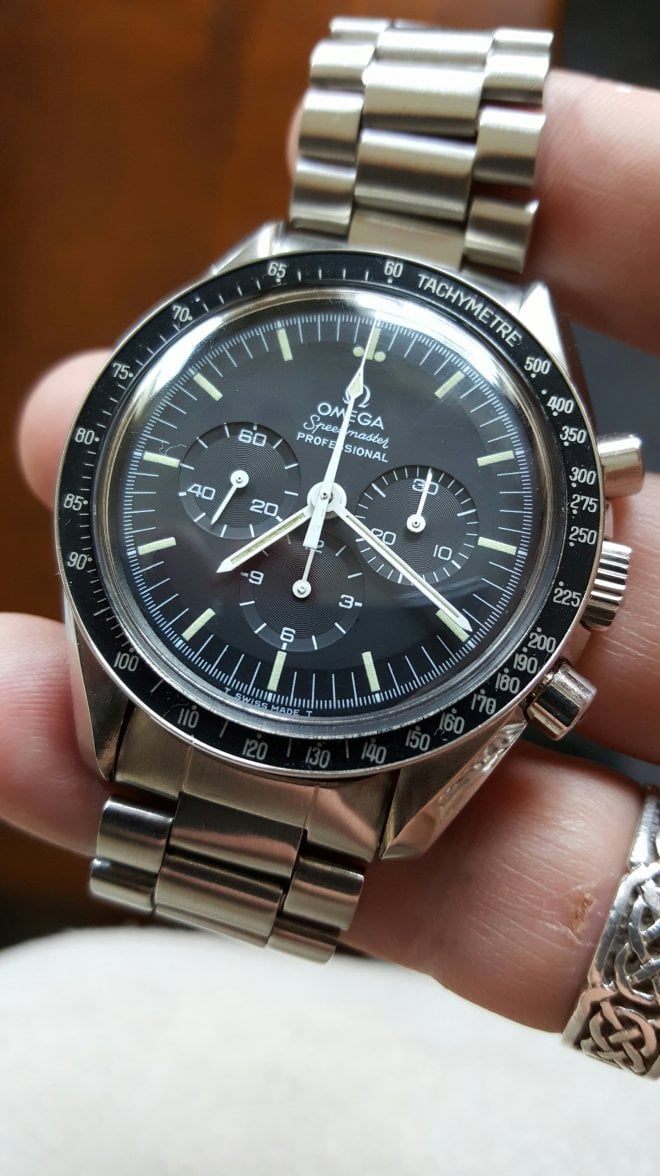
nonuffinkbloke
·Hello @mr_yossarian. Unless I'm mistaken... it fits just fine with the new edition MWO serial number ranges. They now place the top end of the 105.012-66 range at 25.448.XXX
We owe a debt of thanks to the guys that research and produce these valuable resources such as Speedmaster101 and Moon Watch Only, but as more examples of genuine watches manifest themselves these serial ranges naturally evolve. In fact if you look at the Serial Quick Reference section in Speedmaster101 William states, in the footnotes that MWO shows slight differences in one or two items.
Evidence of these adjustments can be found in the MWO revised serial ranges for 105.012 for 1965 and 1966.
NOTE: (Was going to post the copies but I am not sure how that sits with copywright laws and I don't want to cause any problems)
I would encourage members to consult the new edition of Moon Watch Only to view the revised serial ranges for 105.012-65 & the serial ranges for 105.012-66.
The 2nd edition MWO serial range for production year 1967 -1968 places @mr_yossarian 105.012-66 with serial number 254438XX in the correct range.
The MWO revision for production year 1966-1967, with the new top end of the 105.012-65 range at 24.537.XXX now places my own 105.012-65, with movement serial 24.531.XXX, in the correct range.
Edited:
JMH76
·Anybody know does MWO give serial numbers and/or production dates for the 3590.50?
mr_yossarian
·Hello @mr_yossarian. Unless I'm mistaken... it fits just fine with the new edition MWO serial number ranges. They now place the top end of the 105.012-66 range at 25.448.XXX
We owe a debt of thanks to the guys that research and produce these valuable resources such as Speedmaster101 and Moon Watch Only, but as more examples of genuine watches manifest themselves these serial ranges naturally evolve. In fact if you look at the Serial Quick Reference section in Speedmaster101 William states, in the footnotes that MWO shows slight differences in one or two items.
Evidence of these adjustments can be found in the MWO revised serial ranges for 105.012 for 1965 and 1966.
NOTE: (Was going to post the copies but I am not sure how that sits with copywright laws and I don't want to cause any problems)
I would encourage members to consult the new edition of Moon Watch Only to view the revised serial ranges for 105.012-65 & the serial ranges for 105.012-66.
The 2nd edition MWO serial range for production year 1967 -1968 places @mr_yossarian 105.012-66 with serial number 254438XX in the correct range.
The MWO revision for production year 1966-1967, with the new top end of the 105.012-65 range at 24.537.XXX now places my own 105.012-65, with movement serial 24.531.XXX, in the correct range.
..even the "old" edition did place my serial in range, it's 254438 not ****83
incabloc
·WurstEver
·Thanks @incabloc! I won't attempt to predict the production date for the Seamaster just yet. The Speedy is an interesting case though ...
Hartmann's table: 1970-1971 (CORRECT YEAR, BUT IMPRECISE 2-YEAR PREDICTED RANGE)
Polynomial model: February, 1971 (INCORRECT YEAR, OUT BY 5 MONTHS)
Linear interpolation: September, 1970 (BINGO! CORRECT YEAR AND MONTH)
This watch fell between two close observations in the existing data set, so the linear interpolation method worked beautifully. Well done, @JMH76 for suggesting this approach! The polynomial model missed by 5 months. We would probably now consider that to be a pretty bad miss; which I suppose shows how far things have come in a relatively short period of time. It's possible most people would care more about hitting the correct year than about the absolute accuracy in terms of months; so from that perspective, this outcome is not ideal. Hartmann's table predicted a two-year range and scored a hit.
The immediate challenge seems to be to determine the conditions under which each of the new methods performs best (which is almost certainly going to have something to do with proximity to other data points and local changes in the slope of the curve). I'll turn my attention to that next. Right now, I'm wondering if a two-step process might be the most effective approach: first apply a rule for selecting one of the two prediction methods, then implement that method to yield an estimated production date. However, I've not yet looked at the relationship between the estimates arising from each method - maybe there's a better way, such as those mentioned by @eugeneandresson a few posts ago. This is a lot of progress in not very much time, and it's all thanks to the contributions from the awesome members of the OF community. Really great stuff 👍
Hartmann's table: 1970-1971 (CORRECT YEAR, BUT IMPRECISE 2-YEAR PREDICTED RANGE)
Polynomial model: February, 1971 (INCORRECT YEAR, OUT BY 5 MONTHS)
Linear interpolation: September, 1970 (BINGO! CORRECT YEAR AND MONTH)
This watch fell between two close observations in the existing data set, so the linear interpolation method worked beautifully. Well done, @JMH76 for suggesting this approach! The polynomial model missed by 5 months. We would probably now consider that to be a pretty bad miss; which I suppose shows how far things have come in a relatively short period of time. It's possible most people would care more about hitting the correct year than about the absolute accuracy in terms of months; so from that perspective, this outcome is not ideal. Hartmann's table predicted a two-year range and scored a hit.
The immediate challenge seems to be to determine the conditions under which each of the new methods performs best (which is almost certainly going to have something to do with proximity to other data points and local changes in the slope of the curve). I'll turn my attention to that next. Right now, I'm wondering if a two-step process might be the most effective approach: first apply a rule for selecting one of the two prediction methods, then implement that method to yield an estimated production date. However, I've not yet looked at the relationship between the estimates arising from each method - maybe there's a better way, such as those mentioned by @eugeneandresson a few posts ago. This is a lot of progress in not very much time, and it's all thanks to the contributions from the awesome members of the OF community. Really great stuff 👍
lando
·JMH76
·Can you put up a graph with all the new points shown? Maybe we can put out a general call for more data on a new thread and/or in multiple sections of OF (or other forums such as Watchuseek) or get one of the bloggers to mention us. We could also request certain datapoints most likely to help us.
